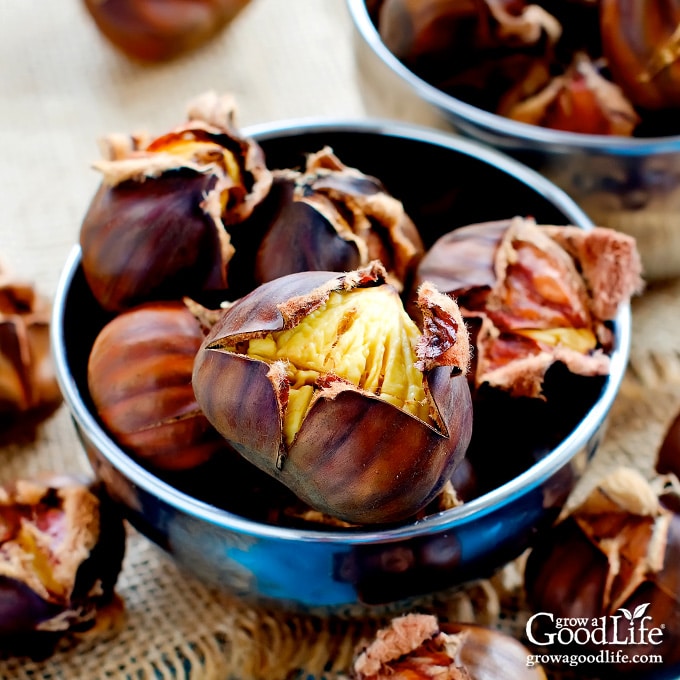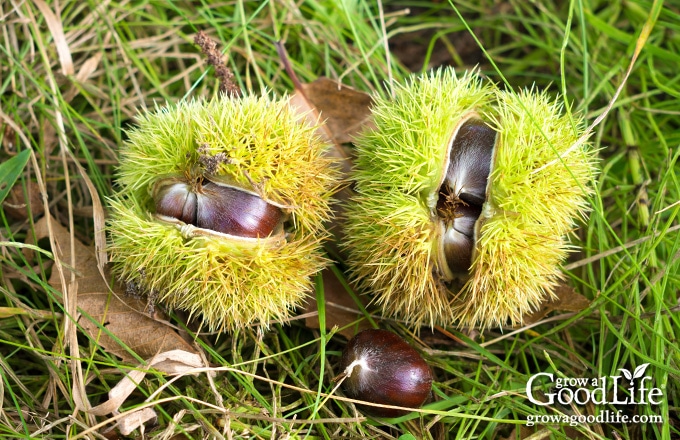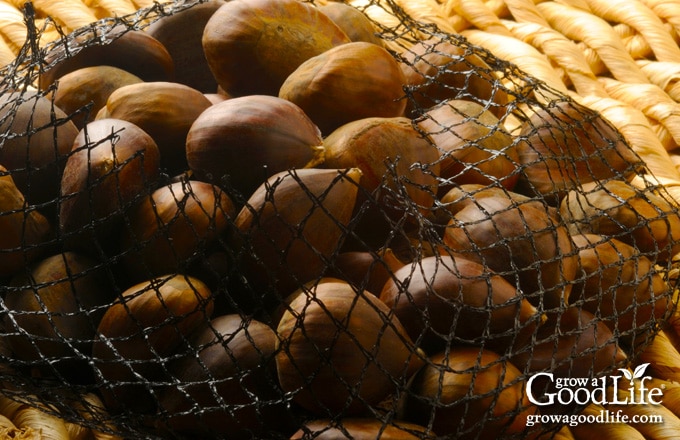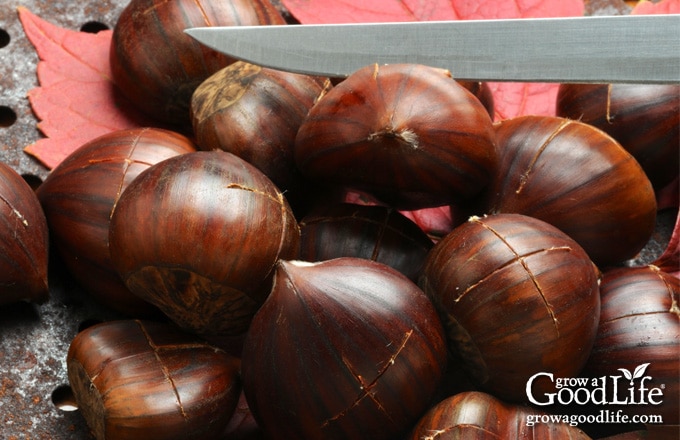How to Roast Chestnuts
This post may contain affiliate links, which means that I may receive a commission if you make a purchase using these links. As an Amazon Associate I earn from qualifying purchases.
Freshly roasted chestnuts are a favorite holiday treat, but you don’t need an open fire to make them. Learn how to roast chestnuts in the oven, plus other ways with this easy to follow guide.

We’ve all heard the song, “Chestnuts roasting on an open fire…” from Nat King Cole’s “The Christmas Song.” But have you ever roasted your own chestnuts?
With the holidays approaching, many of us turn to old-fashioned ways we celebrated the season. There is something about the toasty smell and flavor of roasted chestnuts that just brings back memories of family and friends gathering around a fire.
What are Chestnuts?
Chestnuts are edible nuts that grow in green, spiky shells on chestnut trees. Each spiny husk can contain 1 to 3 deep brown-shelled chestnuts.
The trees are native to many places around the world, with four main species producing edible nuts, the American chestnut, Chinese chestnut, European chestnut, and the Japanese chestnut.
American chestnut (Castanea dentata) trees once occupied over 200 million acres of the eastern part of North America. They were considered the world’s most important tree that provided both strong, rot-resistant wood and edible nuts.
Everyone had a few chestnut trees on their property or knew of some nearby that they could forage and use the nuts to make chestnut flour, and in recipes from soups and stews to Thanksgiving turkey stuffing.
Sadly, by the 1950s the magnificent trees were gone. An imported fungal disease, called chestnut blight spread quickly infecting and killing the mature trees.
It isn’t unusual to discover a seemingly resistant grove of trees here and there when hiking. These young trees sprout up from the roots of ancient chestnut trees. These trees can live and produce chestnuts for up to 20 years, but they eventually tend to succumb to the fungus and die.
Progress is being made in hopes of restoring resistant American chestnut seedlings to the landscape, and efforts have been made to develop blight-resistant hybrids. Do a search for chestnut orchards in your area and you may discover a local source of fresh chestnuts perfect for roasting.
Tips for Roasting Chestnuts
Roasted chestnuts are delicious when they are done right. They don’t get crunchy like most nuts, but are chewy and creamy with a mild woodsy flavor. They can be a bit tricky to roast properly and peel. Read on for tips on how to roast your chestnuts over a fire, in an oven, air fryer, or on the stove.
Choosing Chestnuts
Chestnuts are available in grocery stores from October to December. Most are imported from Italy, France, and China, but you may find a local source at farmers’ markets.
Chestnuts need to remain cool after harvesting to stay fresh. Look for chestnuts in the refrigerated section of your product department. They may be packaged in mesh bags or in baskets. Loose is good because you can sort through to find the best ones.
When picking your chestnuts, choose ones that look healthy, and have shiny brown shells without cracks or splits. The nuts should feel heavy and firm without much give when squeezed gently. Avoid chestnuts that are dull in color, feel soft, or rattle when shaken. These may be overripe, moldy, or shriveled up in the shell.
Store the chestnuts in the fridge until you are ready to roast them. Chestnuts don’t stay fresh for long. Plan to roast within 2 or 3 days for the best results.
Harvesting Chestnuts
If you happen to have access to chestnut trees, the nuts are ready for harvesting once they break open or fall off the tree starting in early October. It is best to grab the ones still enclosed in the spiked hulls to avoid insect damage.

Make sure you are able to tell the difference between edible chestnuts and toxic species like horse chestnut or buckeyes
Fresh harvested chestnuts need to be cured for several days to develop their flavor. As the chestnuts cure, they dry out a bit, shrinking the kernel, and pulling it away from the shell. Curing also converts the starch to sugar, giving the chestnuts the sweet nutty taste we enjoy.
To cure chestnuts, remove them from their spiny shells, place them in a single layer on a tray, and leave them at room temperature, between 65 and 75˚F, until they are cured. Toss out any nuts with damaged or cracked shells, or pinholes to avoid worms.
Check the chestnuts daily by squeezing the nut. Chestnuts are finished curing when you feel a slight give between the outer shell and nut. Curing can take 2 to 4 days depending on the chestnuts and the humidity in the air. Don’t let the chestnuts cure longer, or they will become too hard to eat.
Once the chestnuts are properly cured, they are ready for roasting. If you cannot roast them right away, store the chestnuts in a breathable paper bag in the coldest part of your refrigerator for about a week.
Should you Boil Before Roasting?
If your chestnuts are older, which is likely if they are not local, they may have dried out a bit. Boiling adds some much needed moisture by plumping the meat and hydrating the shell and inner membrane for easier peeling.
To boil your chestnuts, cut an X slit in the shell, and then boil them in a pot of water for about 5 minutes and drain. Proceed with your roasting method, but cut the time in half, and watch carefully so they don’t overcook.
Be Prepared for Duds
Don’t be disappointed if there are a few chestnuts that go to waste after roasting. Sometimes you can’t tell until the shells are removed, but some chestnuts may be moldy on the inside. Discard any chestnuts that are black, moldy, or otherwise show signs of spoilage.
Additionally, there will be a few chestnuts that just won’t roast well, and remain hard, or so soft that they fall apart when you touch them. You may also find a few stubborn nuts where the shell or membrane refuses to peel off. Soak these in hot water, or scoop out the edible part as best as you can with a spoon.
Ways to Roast Chestnuts
Over an open fire is what most of us think of when roasting chestnuts, but there are many ways to accomplish this, including a wood stove, air-fryer, grill, on a stovetop, and in the oven.
With any method you choose, be sure to wrap the chestnuts in a towel after roasting to keep them warm and allow them to steam to make peeling easier. Start peeling as soon as they are cool enough to handle, and keep the remaining chestnuts warm as you work.
Roasting Chestnuts Over Fire
There is a special pan made for roasting chestnuts over hot coals in the fireplace or outdoor fire pit. It’s round and has holes in the bottom to let the heat circulate around the nuts, and a long handle so you don’t burn your hands.
Trick to roasting chestnuts on an open fire is to place the chestnut pan on coals, instead of over flames. Let the fire burn down to embers. Use a few bricks to elevate the pan several inches from the coals, and place the pan of prepared chestnuts over the heat to roast. Shuffle the pan frequently to turn the chestnuts so they heat evenly, and watch closely so they do not burn.
In a Wood Stove
My husband’s family celebrated the holidays by roasting chestnuts in their Ben Franklin wood stove. They wrapped the chestnuts into bundles of aluminum foil and placed the packet on a bed of hot coals. The packet was turned frequently to roast the chestnuts evenly.
Air-Fryer Roasted Chestnuts
The air fryer is a perfect way to roast chestnuts. The perforated basket heats the nuts evenly, and they are not likely to burn.
Preheat the air-fryer for 5 minutes at 400˚F. Toss in the prepared chestnuts and shake to distribute in a single layer. It’s ok if they touch, but don’t over fill the basket. Air fry the chestnuts at 400˚F for 10 to 15 minutes. Pause part way through to give the basket a shake to help the chestnuts cook evenly.
Roasting Chestnuts on a Grill
A grill basket, the type you use to roast vegetables is the perfect vessel for roasting chestnuts on a gas or charcoal grill. It not only prevents the nuts from falling through the grill, but the holes let the heat through to help cook the chestnuts evenly.
Preheat your gas grill to 400˚F. If you are using a charcoal grill, set it up for direct heat, light the charcoal, and heat until the fire is medium-hot. When the briquettes are ready, spread them evenly beneath the cooking area.
Place the prepared chestnuts in a grill basket, set it over the heat, and close the lid. Roast the chestnuts for 10 to 15 minutes, or until done. Give the basket a shuffle every 5 minutes to help the chestnuts cook evenly.
Skillet Roasted Chestnuts on a Stovetop
A cast iron skillet is a great pan to use because it heats evenly, and holds on to the heat better than other pans. To roast chestnuts on a stove top, preheat the pan over medium heat, add the prepared chestnuts in a single layer, and roast for 10 to 15 minutes. Give the pan a shake every 5 minutes to flip the chestnuts, so they cook evenly.
Steps to Roasting Chestnuts in the Oven
The smell of roasting chestnuts is the smell of the holiday season. With a toasty aroma and a sweet, buttery flavor, roasting your own chestnuts is well worth the effort. Lucky for you, it’s not difficult either.
The full, printable recipe can be found at the bottom of this article, but here are the illustrated steps for roasting chestnut in the oven.

Step 1: Prepare the Chestnuts
Rinse the chestnuts under running water and place them on a clean kitchen towel. Discard any that are damaged or cracked.
Position the chestnut flat side down, and cut an X-shaped slit with a sharp knife or serrated knife on the round side of each chestnut. You want to penetrate the shell and membrane, but try not to cut the nut.
Scoring the shells will let the steam escape as the chestnuts cook. The skins also separate and curl away from the slit giving you an easy way to peel the shells.

Step 2: Roast the Chestnuts
Place the prepared chestnuts flat side down in a single layer on baking sheets. Roast in a preheated oven until tender, about 15 to 20 minutes. Watch them carefully because the cooking time will vary. The chestnuts are cooked once they smell nutty, the shell splits open and curls away from the cut opening, and the meat can be pierced easily with a fork.
Once the chestnuts are roasted, remove the baking sheets from the oven. Cover with kitchen towels, and let the nuts cool slightly.

Step 3: Peel the Chestnuts
The shells are easier to remove when still warm. Peel the skins off the nuts as soon as they are cool enough to handle. Work with one at a time, and keep the remaining chestnuts under the towel to stay warm.
Remove both the outer shell, and rub off the inner brown membrane with your thumbs or a towel. Discard any that are dark in color or moldy. Repeat with the remaining roasted chestnuts.

Chestnuts taste wonderful warm right from the oven. Store extras in an airtight container in the refrigerator for up to 3 days.
How to Roast Chestnuts
Ingredients
- 1 pound fresh raw chestnuts
- water optional – see notes
Instructions
- Preheat the oven to 400˚F.
- Sort through the chestnuts and remove any damaged or cracked nuts.
- Rinse the chestnuts with water to remove dust and debris, and place them flat side down on a clean kitchen towel.
- Cut an X-shaped slit in each chestnut with a sharp or serrated knife.
- Place the prepared chestnuts flat side down in a single layer on baking sheets.
- Bake in a preheated oven until roasted, about 15 to 20 minutes. The chestnuts are done once they smell nutty, the shell splits open and curls away from the cut opening, and the meat can be pierced easily with a fork.
- Once the chestnuts are roasted, remove the baking sheets from the oven. Cover with kitchen towels, and let the nuts cool slightly.
- Remove the shells as soon as the chestnuts are cool enough to handle. Peel the outer shell, and rub off the inner brown membrane with your thumbs or a towel.
- Enjoy warm chestnuts right away, or store in an airtight container in the refrigerator for up to 3 days.
Notes
Nutrition
You May Also Like:
10 Cookie Mix in a Jar Recipes eBook
Homemade gifts are always appreciated because they come from the heart. Even if you are not crafty, you can give DIY gifts to your family and friends with these easy recipes for making cookie mix in a reusable jar.


